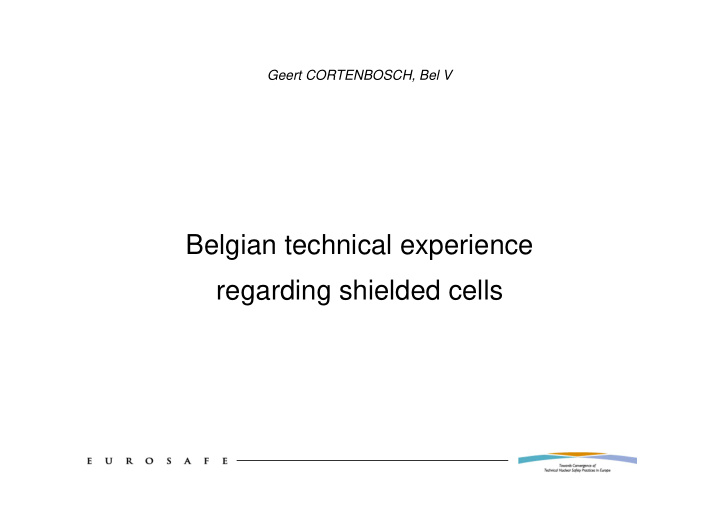



Geert CORTENBOSCH, Bel V Belgian technical experience regarding shielded cells
Topics of the presentation Situation in Belgium Type of events – Radioactive gas releases – Underpressure loss – Fire – Handling – Contamination Points of attention
Situation in Belgium (1/3) Bel V = Subsidiary of the FANC (Federal Agency for Nuclear Control) Bel V + FANC = regulatory body in Belgium, Bel V = TSO Bel V: to carry out the surveillance of the Belgian nuclear installations within the frame of the Belgian laws and regulations FANC Bel V AVN Controlatom Techni-Test
Situation in Belgium (2/3) 7 NPP’s (Doel & Tihange) Research Centre at Mol (SCK•CEN) Waste (Belgoprocess) MOX fuel (Belgonucléaire) Isotope production (IRE) Research reactor Thetis (UG) Universities Hospitals
Situation in Belgium (3/3) Bel V = Technical Support of the Federal Agency for Nuclear Control – Nuclear Safety Assessments : Safety Evaluation Reports – Conformity checks of new plants/installations or modifications : issuance of licenses – Inspections : written reports
Radioactive gas release Unplanned release of I-131 due to unexpected chemical reactions (oxydo-redox reaction) in a tank collecting liquid wastes of shielded cells – Weak dilution – Simultaneous transfer – Waste had short decay time – Slow decomposition rate of H2O2 – Transfer under vacuum
Radioactive gas release – lessons learned Filtration – Chemical form – Efficiency Chemical fluxes management – Separation – Avoid involuntary tranfers – Traceability – Use of minimal quantities Air monitoring – Available at any time – Diversity and redundancy – Discrimination
Loss of underpressure in hotcell Unexpected opening of a door by actuation on a non- protected touch-sensitive screen – Resulted in the loss of underpressure in a cell during 48 hours (cell contained 800 Ci – 29,6 TBq (I-131 in a basic form)
Loss of underpressure – lessons learned There was no sound alarm and no alert message on screen Touch-sensitive screen not protected towards untimely actions and absence of software protection No traceability of underpressures No procedures regarding emptying of lines
Fire Fire in oil remnants (sparks during cutting out phase of a glove box) – Fire-resistant blanket, did not work – Extinction system did not work (fold in the hose) – Housekeeping Fire in rubber band of a wheel Fire in the rubber part of a remote handling system in contact with a heater
Fire – lessons learned Appropriate fire detection and extinction available at any time (verification through regular testing) Prior to every manipulation, handling task should be analyzed Line clearance after any operation Training of operators
Handling of radioactive products Bringing out of a supplementary tube containing Cs isotopes (doserate 2.9 Sv/h) via a La Calhène port during a distallation phase – Dose of 124 µSv for the operator Fall of a La Calhène jar between air lock door and a transport container
Handling of radioactive products – lessons learned Set-up of a procedure regarding measurement and bringing out of the cell Input in an ALARA database Training of the personnel Work preparation
Contamination Work on damaged irradiated products lead to contamination of shielded cells, workplace and operators – Irradiated products presented a burnt aspect (production of dust, material could easily be broken) – 2000 Bq max internal contamination
Contamination – lessons learned Lack of interrogative attitude Appropriate monitoring and interlock system Adequate protection means (gloves, respiratory protection, contamination check) Transfer valves actuated pneumatically Training of operators (procedures)
Points of attention Ventilation Product fluxes Monitoring Process Filtration Failsafe components Training Alarms Fire protection Leaktightness Interlocks Transfers between airlocks
Thanks for your attention Any questions ?
Recommend
More recommend